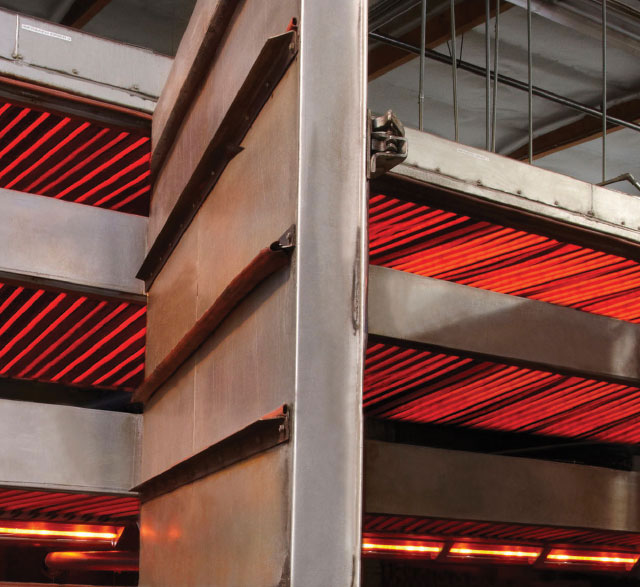

you have questions-
We have answers
We offer our customers comprehensive sales support and design assistance to help you select a system that will best meet your particular needs. Do you have a question that has not been answered below? Please contact us for prompt, professional service.
What is the difference between short wave, medium wave and high intensity infrared energy?
Unlike other infrared competitors, Infratech specializes in, manufactures and sells all three types of electric infrared units. Short wave infrared, also known as halogen, tungsten, T3 emitters or Infratech’s trade name, “Iridium”, is the hottest and fastest heating option available. This option features the most advanced heating technology. It is characterized by a narrower wavelength of heat with a peak spectral output that falls approximately within the 1.3 micron range, just past that of visible light. Virtually all short wave emitters will operate at approximately 3,500 degrees Kelvin. This technology produces bright white light that can be filtered to reduce its glare, but may still strain visibility. Short wave heating units are “instant on” and feature a higher watt density per inch of emitter length.
Medium wave units, or tubular quartz elements, are generally considered a better value and cover a larger area with heat at a lower cost. These heating units have a peak output in the 2.3 micron range. With this technology, the heating element operates at approximately 1,600 degrees Fahrenheit, and will produce a dull orange glow when in operation that generates minimal visible light. Medium wave units are less color sensitive, a feature which offers more consistent panel temperatures and cure times between light and dark colored finishes. Drying times may be between one to five minutes longer than short wave heaters, depending upon the size of the area and the material being cured.
High intensity infrared is a term Infratech uses to describe medium wave units that offer higher watt densities relative to the area covered. Infratech’s high intensity units will generally offer faster drying times and can reach higher temperatures than standard medium wave units.
What temperature will an infrared heater reach?
There are a number of considerations that may affect the final product temperature. Standard Infratech portable automotive/industrial curing lamps are designed to accelerate the curing of any liquid coating that will eventually air-dry on its own. When used between 18″ and 36″ from the surface of the drying substrate, an Infratech heater will generally reach target temperatures from 140° F to 200° F. These variances depend upon a range of factors, including actual heater model, size of the area to be dried, product mass relative to surface area, heater distance from the product, exposure time and ambient conditions.
Do Infratech heaters cure powder coatings?
Infratech manufactures only one series of portable lamps specifically for powder coating applications. Our HO 6000-P and HH-1800 units need to be positioned 2″ – 6″ from the surface to be cured, and should be monitored closely to ensure that the part achieves the desired curing temperature. Smaller lamps like the SRU-1615 and SRU-1615-HT have also been used to cure powder on small, thin-gauge, light-weight parts. It is ultimately up the end user to determine whether their heating lamp is suitable to be used for a specific application, and whether shop conditions support this use.
How long will the bulb last?
Bulbs for both Infratech short and medium wave elements are rated for 5,000 hours. Typically a shop will achieve 5-10 years of continual use, depending upon conditions. It is far more common for bulbs to be broken due to improper handling than it is for them to actually fail. For this reason, Infratech lamps – particularly short wave units – should not be moved or rolled around while the unit is hot or in operation. To extend bulb life, lamps should also not be used in the vertical position unless it is absolutely necessary (on units that allow vertical positioning). The fine-gauge filament in the short wave emitters is sensitive to vibration and can be more easily damaged by rolling on uneven surfaces.
Do Infratech lamps create any harmful UV or safety issues?
Infratech medium wave units emit no measurable UV energy. Infratech iridium, or short wave units emit UV in negligible quantities. When working in close proximity to short wave units, workers should always use appropriate eye protection, in order to prevent eye fatigue or irritation from the bright glare. Operators exposed to the heat should take the same precautions as used whenever working near any oven or equipment with a hot surface.
Does Infratech offer products with voltages other than 120 V or 240 V?
Yes. We offer alternate voltages for medium wave units, including single and three phase options on some models. 208, 277 and 480 volt units are some that are most commonly requested. Infratech short wave emitters are only available in 120 and 240 V configurations. Our larger iridium units will operate on 208 V power, but will not generate the full-rated heat output.
Will infrared technology work on fiberglass, aluminum, or other materials?
Infrared heat works to accelerate the drying of virtually any material that would naturally dry on its own. With substrates of different densities, including steel, aluminum, wood, fiberglass or plastic, the heat-up time will vary, but the results will be comparable. On lightweight or thin material, it may be necessary to program the heating unit to operate at a lower temperature, or position heaters at a greater distance in order to prevent overheating the substrate.
Can Infratech units be used in hazardous locations?
No electric equipment can be used in a spray booth or other hazardous location, while spraying is in progress. National Electric Code (NEC) 516.4, Paragraph (D) states: “Portable electric lamps or other utilization equipment shall not be used in a spray area during spray operations.”
Do you have a question that has not been answered? Contact us.
